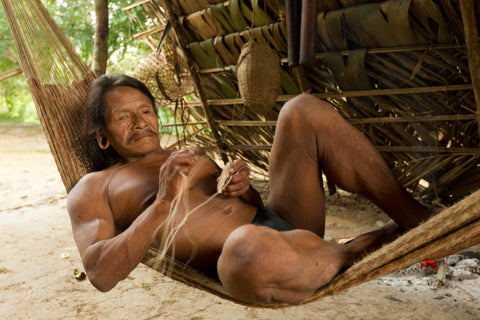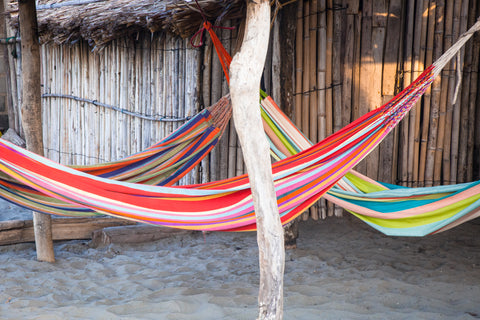
Where are Hammocks Originally From? A Brief History of Hammocks
In the modern world, hammocks are mostly used for relaxing on the beach, sunbathing in the backyard, or for creating an adventurous aesthetic in your home.
However, that wasn’t always the case. Sleeping in a hammock has numerous health benefits, even today. But the hammock was initially invented for very different reasons.
If you’re curious about where hammocks are originally from, keep reading to learn a brief history of hammocks, including where they originate, why they were used, and how they were made.
Where are Hammocks Originally From?

The hammock was first invented by the native indigenous inhabitants of Central and South America, including countries like Mexico, Guatemala, Nicaragua, El Salvador, Costa Rica, Brazil, Ecuador, and many others.
Natives only ever slept in hammocks, not beds or mattresses. Because they are raised off the ground, they were considered safer, cooler, and more comfortable than sleeping on the floor.
We don’t know exactly when the hammock was first developed. Christopher Columbus “discovered” them in the late 1400’s when he traveled to the Bahamas.
However, the tribes likely used hammocks as beds for centuries before Columbus found them, so their exact date of invention is unknown.
Why Did People Start Sleeping in Hammocks?

When they were first invented by the indigenous tribes, the hammock was routinely used as a bed. They were usually positioned underneath an open-air hut or hung between two trees.
Because of the climate and environment in Central and South America, the indigenous tribes used the hammock because:
- It kept them away from snakes, critters, and other wild animals that roamed the floors during the night
- The breathable material kept them cool on humid nights
- They were lightweight and portable, making it easy to transport them during hunting trips
- It kept them off the wet ground during the night
Once Christopher Columbus brought the hammock to Europe, sailors and pirates started to adopt them as beds on their ships. They were even used by the Navy for around 300 years (between the 1600-1900’s).
Aboard ships, hammocks were useful because:
- They were cheap
- They were lightweight, which often meant the ship could carry more cargo
- They were safer, as they prevented sailors from falling out of bed during rough seas and getting injured
- They saved space
- They could be used as a floatation device in an emergency
- They prevented seasickness with their continuous rocking (unlike a bed, which remains still and “against” the motion)
Years later, astronauts who visited the moon used hammocks on spaceships in replace of a bed. Because they were so small and lightweight, they were the ideal solution for a spacecraft with strict space and weight restrictions.
Eventually, hammocks started being used by the general population. For a long time, they were a luxury item, used outdoors to relax in the shade.
They were also used as a type of child’s crib. The gentle rocking was soothing for babies and helped them fall asleep quickly and comfortably.
Nowadays, people often sleep in a hammock for the various health benefits they provide. Because of their stretchy material, they can be very comfortable, especially if you have back or neck pain.
They can also promote better sleep health. More recent studies have shown that modern-day users can fall asleep faster and into a “deeper” state of sleep when using a hammock as a bed.
What Were Hammocks Traditionally Made From?
Originally, the indigenous tribes made their hammocks from the bark of a Hamack Tree (which explains where the name “hammock” came from!).
However, they quickly switched to fibers from the Sisal plant instead. It was easier to grow, more readily available, and more comfortable. Unlike the tree bark, the Sisal plant could be softened when rubbed against the thigh before weaving.
As time passed, people started using cloths and fabrics to make hammocks. These were particularly desirable in some European countries and on sailboats, as they helped people stay warm, rather than cool.
Later, people started making hammocks from netting and rope. These grew particularly popular on beaches to keep you cool under the sun.
Nowadays, hammocks are most commonly found made from materials like nylon, cotton, polyester, canvas, or silk.
How Did Hammocks Become Popular?
It was Columbus who popularized the hammock across the world.
When he “discovered” them in the 1400’s, he quickly realized their potential. Not only did he bring several designs back to Europe with him, but it’s also rumored he slept in one on his way home!
Soon after bringing them to Europe, the hammocks soared in popularity. They became widely used by sailors, the Navy, the general population, and, eventually, astronauts.
Why Do People Still Use Hammocks Today?
Nowadays, hammocks are used for just about anything.
They are still used as a bed in various places across the world, particularly in countries with extreme heat and dangerous wildlife. They help people stay cool, dry, and safe during the night.
But it’s not only hot countries that use hammocks as beds in the modern world. Hikers and campers often use traveler hammocks because of how comfortable, convenient, and lightweight they are.
Many health professionals and physiotherapists also recommend sleeping in a hammock, particularly if you have insomnia or experience back/neck pain.
However, owning a hammock today isn’t all about practicality! They are luxurious, comfortable, and provide endless opportunities to relax in the comfort of your own home.
Many people choose to get a hammock for the backyard so they can relax in the shade, sun, or by the poolside. Others prefer to get a hammock chair for their balcony, porch, living room, or home gym as a comfy, convenient, and aesthetically pleasing chair.
Find Your Perfect Hammock Today
Bring a taste of the Caribbean home with you and find the perfect hammock for you today!
At Caribbean Hammocks, our hammocks are made from soft-spun polyester cord with a microwave design for unmatched flex and support. Our materials are rot, mold, and mildew resistant, so you’ll never have to worry after using them by the poolside or in the backyard.
You can use our hammocks outside in the garden, in replace of a bed indoors, on a camping trip to the forest, or just about anywhere else!
Explore our collection of hammocks, hammock chairs, and hammock stands now.
